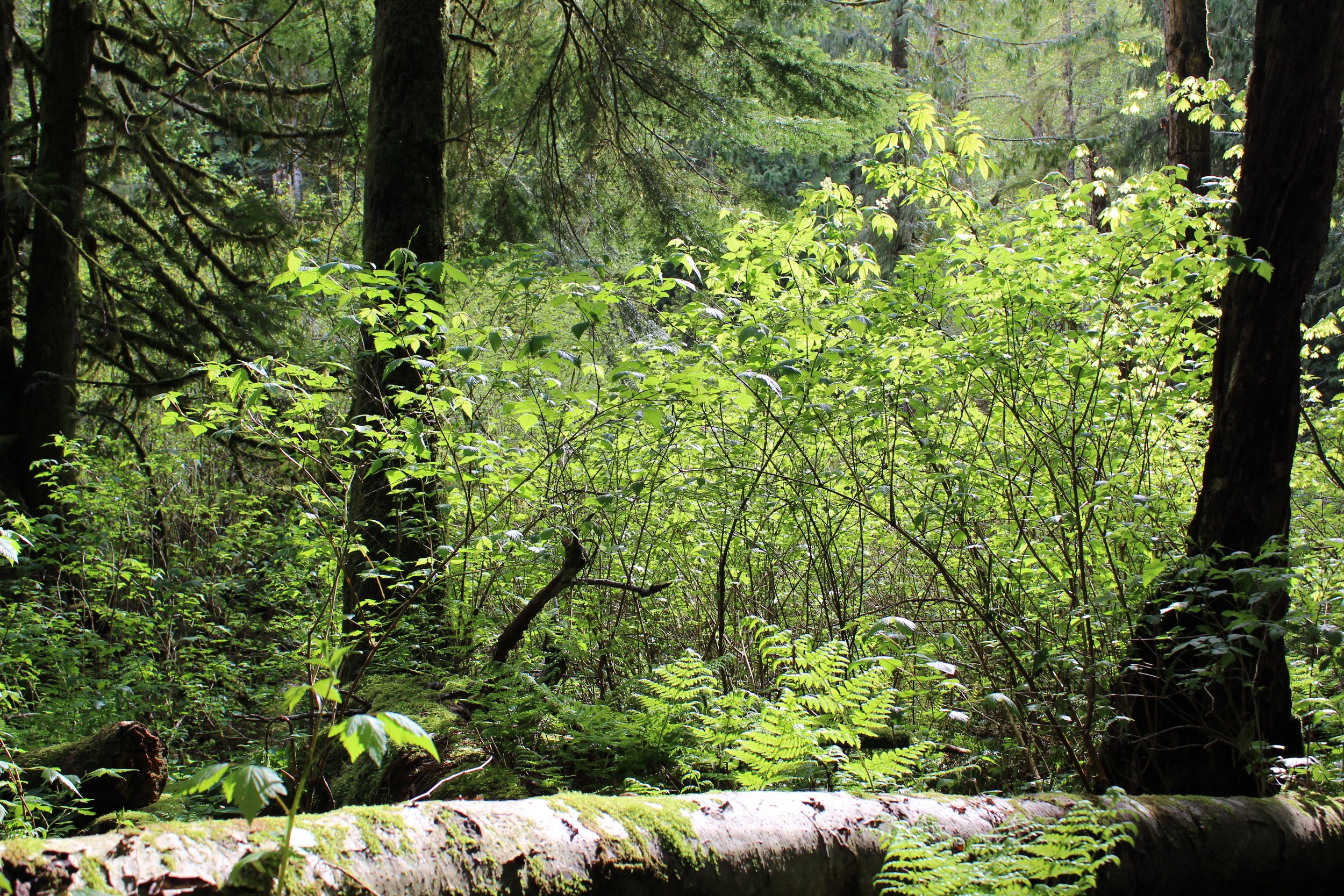Foraging for Community
Western students are turning to local parks and green spaces for food, friends and an escape from hectic college life.
Shelf mushrooms grow on a log at Lake Padden. // Sof Dubois
Story by Lyla Biddle // Photos by Sof Dubois
June 8, 2022
It’s spring at Western Washington University. Students are enjoying the sun while they hammock between trees, toss frisbees and bike along campus pathways.
Deep in the shade of the Outback Food Forest, a group of students are making the most of the sunny day in another way.
Foraging Club members collect and nibble on edible plants like mint, lemon balm and oxalis, a leafy ground cover that resembles a large clover. These students enjoy slowing down to appreciate the sight, smell, touch and primarily taste of the natural beauty around them.
Students proceed in a line to search for items to forage at the Outback Farm in Bellingham, Washington. // Lyla Biddle
Classes at Fairhaven College, the Outback Farm and the newly established Foraging Club have encouraged students to forage wild foods that come at a price much cheaper than grocery store alternatives: free.
The recent surge in foraging popularity can be partly attributed to people’s desire for increased food sovereignty and security, according to a study from the “Journal of Urban Ecology.” Foragers find a sense of community through learning about, harvesting and later enjoying local plant species together.
Al Short, a fourth-year student, was surprised to learn there wasn’t a foraging club at Western when they enrolled in 2019. Short has fond memories of middle school when they collected huckleberries and salmonberries to make jam and discovered the wonders of foraged foods for the first time.
“It’s such a growing interest with people right now,” Short said. “I wanted to start a club to form a good sense of community, and also teach people some good ways to harvest.”
Short appreciates the opportunity to relax in nature as they forage for wild plants.
For students living in a world of busy class schedules, part-time jobs and extracurriculars, time spent outside is a welcome break from the stress of everyday life.
“You could just go through your life without ever stopping to look around,” Short said. “[Foraging] reminds me to slow down and be patient with myself and others.”
During club meetings at the Outback Farm, Short makes sure to highlight the importance of taking the time to trust one’s intuition and respect the space from which one forages.
“If your gut tells you ‘Don't stomp all over this’ or ‘Don't take it, then don't,” Short said.
Foraging club members venture into green spaces like Larrabee State Park or Samish Hill. They’re taught to follow collection guidelines like the one-in-twenty rule, which aptly directs foragers to harvest only one out of every 20 specimens available.
As the popularity of foraging increases, so too does the potential harm to the environment as people of varying skill levels collect edible plants.
A WWU graduate student holds a fiddlehead fern at the Hundred Acre Woods, Bellingham, Washington. Fiddleheads are popular foraging subjects with surprising nutritional value. // Sof Dubois
If one uninformed person over-harvests the buds, berries or roots of a plant, it can cause serious harm. A predictable harvest site can be depleted for seasons to come, not only for other foragers but also for animals, which lack the alternative option of a quick stop at the grocery store.
Additionally, many areas that might be considered fair game for foragers are actually off limits due to their status as preserved land, like the Sehome Hill Arboretum.
One Fairhaven student, Sabine Hopper, hopes to make foraging more accessible not just in the green spaces on the edge of campus, but right on university grounds.
Growing up spending time between the urban bustle of Seattle and their family’s farm in the country, Hopper gained an early appreciation for the nourishment and engagement that foraging provides.
“You just get to be in the woods, and I find it very grounding,” Hopper said. “I don't think it's fair that you should have to not live in the city to get to forage.”
Hopper, a sustainable development and social justice major, plans to use both their school and first-hand knowledge to establish an educational foraging garden within the Outback Farm. The goal is to make foraging more accessible for students living on or near campus who don’t have the money, time or physical capability required to forage.
The garden, located near the south entrance of the Outback Farm, would serve as a real-life reference guide for local plant species, providing clear labels and identification tips to make plants more easily recognizable than they would be in the pages of a book.
Hopper will plant forageables with little to no processing required, like miner’s lettuce or sorrel. Compared to more labor-intensive species like broadleaf arrowhead or camas, which can take up to 48 hours to cook, wild greens provide a small yet nutritious snack that’s easy to grab and go.
“You can have a salad in your hands… you just pick a bunch of stuff, whatever is seasonal, and you can just eat all of that,” Hopper said.
An off-trail meadow area has plenty of abundant greenery. It is full of different foraging options such as ferns and mushrooms. // Sof Dubois
At another Foraging Club meeting, Short, bundled warmly in a wool sweater, watched as members discussed their favorite plant species under the sturdy cedar roof of the Outback Outdoor Classroom. Spirits were high as students sat huddled on chairs around the heat of a small camp stove and called out the names of their favorites: huckleberry, willow and dandelions, the latter of which sizzled in a fritter on the fire in front of them.
Foraging rules are different when it comes to invasive species like the dandelion because they pose a threat to the local ecosystem, but they’re great for beginners, Short said.
“This entire plant is edible and super versatile,” they said.
“Plants don’t have to be villains,” Short said, but humans often fill that role.
Potential contamination from pesticides or road-borne toxins like lead or cadmium can taint otherwise edible plants. Misidentification of a species can also lead to serious consequences, primarily gastrointestinal distress, but in the most extreme cases – death.
To avoid potentially fatal mistakes, beginners can bring a knowledgeable friend along to help with identification, preparation and to enjoy the feast that follows. Another tip for beginners: learn how to identify a few local species with no poisonous look-alikes.
After a successful foraging trip, the club members strolled out of the woods with a bounty of mushrooms, leafy greens and wild herbs. As some members chatted or sketched plants, others arranged the herbs on a picnic bench in preparation for a pot of freshly-brewed tea to ward off the chilly air.
Foraging club members make a soup utilizing foraged goods. // Lyla Biddle
Lyla Biddle is a third-year student at Western Washington University who is majoring in environmental studies.





